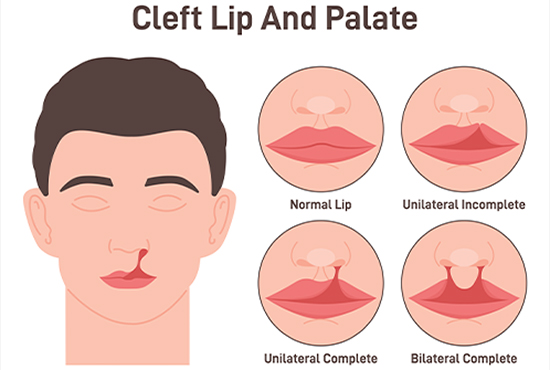

Craniofacial Deformities
Home / Reconstructive Maxillofacial / Craniofacial Deformities
Craniofacial Deformities Beverly Hills, Los Angeles, Glendale CA
The reconstructive craniofacial and maxillofacial surgery specialists at Stepanyan Surgical Arts Center help treat the diverse craniofacial deformities that affect patients physically and mentally. Craniofacial deformities can be acquired due to trauma, ablative surgery for removal of benign and malignant tumors, but most commonly congenital, which are irregular growths of the head and facial bones that affect patients differently. These irregularities are congenital, meaning they are present at birth. The Congenital Craniofacial Deformities can appear in a variety of ways appearing as minor or severe physical deformities that require surgery.
Causes of Congenital Craniofacial Deformities
There’s no single avoidable cause for craniofacial deformities, but studies have found the most common factors that contribute to them. The factors that lead to the development of craniofacial deformities include the following:
- Combination of Genes: Sometimes a certain combination of genes received from one or both parents can lead to a deformity. There can also be a change in the child’s genes at the time of conception which can cause a craniofacial deformity.
Environmental: The studies of the effect of environmental exposures leading to craniofacial deformities is not fully understood and ongoing. However, there seems to be a correlation when in combination with genetic abnormalities.
Common Types of Craniofacial Anomalies
These anomalies can affect anywhere on the face, head and neck, and in some of their severe forms can affect extracranial organs. The most common are relatively minor like cleft lip and palate and the mild forms of hemifacial microsomia and fortunately the most severe anomalies are not as common.
These are some examples of the most commonly discussed craniofacial deformities:

This condition causes partial or full separation in the lip or the palate, roof of the mouth, or both. These are the most common congenital anomalies seen at birth that could affect the child unilaterally (on one side) or bilaterally (on both sides.)
is the second most common birth defect of the face. This condition occurs when the tissue of one side of the face is underdeveloped. The areas that this affects are primarily the jaw, mouth, ear. Sometimes both sides of the face can be affected along with the skull in addition to the face. If severe, it may result in difficulties breathing due to obstruction of the trachea – sometimes even requiring a tracheotomy.
- also known as oculo-auriculo-vertebral dysplasia can be thought of as a particularly severe form of hemifacial microsomia, in which extracranial anomalies are present to some extent. Some of the internal organs (especially the heart, kidneys and lungs) may be underdeveloped, or in some cases absent altogether.
is a genetic disorder characterized by deformities of the ears, eyes, cheekbones, and chin. This condition shares many similarities with Hemifacial Microsomia. The degree to which a person is affected, however, may vary from mild to severe. Complications may include breathing problems, problems seeing, cleft palate and hearing loss.
is a congenital condition recently linked to genetic anomalies at chromosomes 2, 11 or 17. Often called Pierre Robin sequence, the disease is a chain of developmental malformations, each leading to the next. The Condition is characterized by a small-than-normal lower jaw, a tongue that falls back in a throat and airway obstruction. In many cases the child will also have cleft palate.
is a genetic disorder characterized by premature fusion of certain skull bones. When the sutures, or soft spots, in an infant’s skull close too early then problems occur with brain and skull growth, which result in an abnormal head shape. The premature closure of the sutures can cause the pressure inside of the head to increase and the skull or facial bones to change from a normal and symmetrical appearance, causing bulging eyes, strabismus, and hypertelorism (increased distance between the eyes.)
Congenital anomalies of the branchial apparatus are very complex and there are multiple articles describing different combinations of those anomalies. But always consult your doctor and/or cranio-maxillo-facial surgeon, if you have even the very smallest suspicion that your child may have one of those conditions.
Here are some other conditions that often are addressed by Facial Cosmetic and Reconstructive Surgeons since they often cause functional and cosmetic defects:
This abnormality takes the form of a birthmark or growth that is present from childbirth. The malformation consists of different type of vessels that can cause functional or aesthetic issues. These deformities have several classifications that depend on the type of the vessels involved. Some of the different names for vascular malformations include venous malformation, lymphatic malformations, venolymphatic malformations, capillary malformations and arteriovenous malformations.
is the most common benign(noncancerous) tumor of the skin. It is also known as a port wine stain, strawberry hemangioma, and salmon patch. This may be present at birth or develop after the first few months of birth. About 60% of hemangiomas occur in the head and neck area.
A flat spot on the baby’s head. It refers to misshapen or asymmetrical shape of the head that occurs from repeated pressure to the same area of the head. Deformational or positional plagiocephaly is different from craniosynostosis, since in Deformational plagiocephaly there is no fusion of the skull sutures.
Specializing in Cosmetic & Reconstructive Surgery
Dr. Martin Stepanyan is a Board Certified surgeon with over 15 years of excellent education, extensive training and over 22 years of successful practice in the field of Cosmetic &
Reconstructive Surgery and Maxillofacial Surgery.
Surgery for Craniofacial Deformities in Beverly Hills
These deformities can take a heavy emotional toll on the people that bear them. When looking for a surgeon it’s important to not only choose a well regarded and experienced doctor, but empathetic as well. Dr. Martin Stepanyan of Stepanyan Surgical Arts Center exceeds these needs and specializes in reconstructive maxillofacial surgery that improves aesthetic appearance and functionality. With his charity work he showed his passion with multiple trips to Ecuador, Armenia and Russia, where he only performed multiple craniofacial reconstructive surgeries and mostly for children of Ecuador.
Each craniofacial deformity is unique to the patient and as such Dr. Stepanyan provides a custom treatment to meet the needs of each patient. His specialties as a facial cosmetic, reconstructive, oral and maxillofacial surgeon make him one of the most capable to treat these rare defects in the head, face, jaw, neck, and mouth. Contact our office in Glendale to schedule a consultation with Dr. Stepanyan.
Schedule A Consultation For A Craniofacial Deformities In Glendale, CA
Dr. Martin Stepanyan believes in changing his patients’ lives by providing truly individualized care. Offering state-of-the-art treatments and technologies paired with genuine expertise, Dr. Stepanyan will work with you to help you look and feel your best. Your next step is to meet with Dr. Stepanyan and the team at Stepanyan Surgical Arts Center today. Complete our online form or call us at (818) 551-0088. We look forward to meeting you soon!

